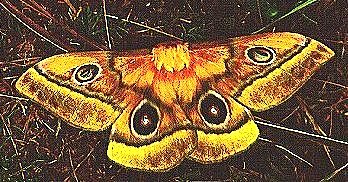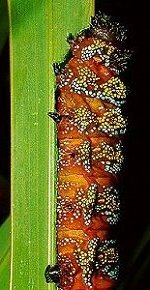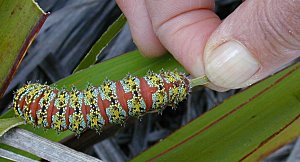|
Family: Saturniidae (emperor moths)
Life
> Eukaryotes >
Opisthokonta >
Metazoa (animals) > Bilateria > Ecdysozoa >
Panarthropoda > Tritocerebra > Phylum:
Arthopoda > Mandibulata >
Atelocerata > Panhexapoda >
Hexapoda
> Insecta (insects) > Dicondyla > Pterygota >
Metapterygota > Neoptera > Eumetabola > Holometabola > Panorpida >
Amphiesmenoptera > Lepidoptera (moths
and butterflies) > Glossata > Coelolepida > Myoglossata > Neolepidoptera >
Heteroneura > Ditrysia >
Apoditrysia > Obtectomera >
Macrolepidoptera >
Bombycoidea

Adult of Pine tree emperor
Imbrasia cytherea.
|

Larva of Pine tree emperor Imbrasia cytherea
feeding on Watsonia leaf in fynbos.
|

Pine tree emperor larva photographed on Watsonia
on the Cape Peninsula (photo by P.A. Hulley - copyright). |
People eat emperor moth caterpillars
"Emperor moth caterpillars are widely consumed in southern Africa. One
of the most difficult periods of the year to survive are the months preceding
the harvest. Fortunately during this period caterpillars can be harvested from
forest trees which foliate before the start of the rainy season. The larvae can
be dried and stored. The most well known emperor moth is Imbrasia belina,
the 'mopane worm'. Large quantities are harvested annually and sometimes
exported to other countries. A canning factory was set up in South Africa some
years ago. However, the unpredictable nature of the occurrence and number of
larvae, and unsuccessful attempts at large scale farming have made this and
other similar enterprises economically inviable (Oberprieler, 1994). The
population dynamics of the species are being studied in order to obtain a more
predictable and sustainable harvest with consequent economic stability (Frears,
1995)." (van Huis
1996)
Subfamilies native to southern Africa
List from Vári et al. (2002).
Publications
-
VÁRI, L., KROON, D.M., &
KRÜGER, M. 2002. Classification and
checklist of the species of Lepidoptera
recorded in southern Africa. Simple
Solutions, Chatswood Australia.
|
|
|
